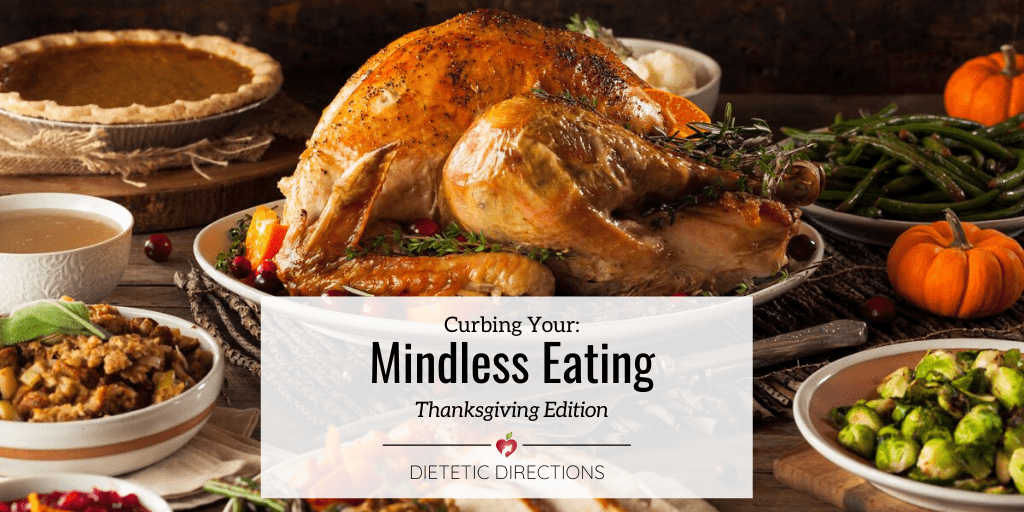
Curbing your Mindless Eating: Thanksgiving Edition
Curbing your Mindless Eating: Thanksgiving Edition: There is a very intricate (and fascinating) science behind why we eat what we eat and why we eat the amounts we do! Without even realizing it, we are inundated with subtle environmental cues, which cunningly lead us to eat more than we otherwise would. Brian Wansink is a food researcher and has written the indispensible book “Mindless Eating” which both exposes and explores these environmental cues in order to provide readers with tips for eating a little ‘less’ without even noticing it! So, in honour of Thanksgiving fast approaching, I thought this would be a timely topic to help us alter our environments so that we can eat (slightly) less, enjoy our Thanksgiving meal just the same and most importantly, guard against the infamous gluttonous feeling that inevitably ensues.
What is Mindless Eating?
Mindless eating is something that we are all guilty of. It is essentially eating on “auto pilot” where we are unaware of what or how much we are consuming. The danger with mindless eating is that it leads to gradual and unsuspecting weight gain; however, the good news is that we can use these same strategies to eat less and lose weight.
Here are my top five tips for you (and your guests) to eat less this Thanksgiving day without feeling deprived.
Andrea's 5 tips to avoid over-eating Click To TweetFive TIPS to help you AVOID Mindless Eating:
1. Replace your 12-inch dinner plate with a 10-inch plate:
People tend to over-serve on larger plates and people eat on average 92% of what they serve themselves. Therefore, think larger plates equals more food consumed! Just a two-inch difference in plate diameter results in 22% fewer calories being served, which is not even a drastic enough difference for our body to detect!
2. See it before you eat it!
Put everything you plan on eating on your plate before you start eating (including dessert if possible). This allows you to regulate or plan how much to eat before the meal instead of during the meal.
3. Avoid Family-Style meals except for Family-Style veggies and salads:
Family style dining is when you leave all the serving dishes on the table so that people may conveniently refill their plates. Moving foods even 6 feet away provides time to think (and get up) if you are desiring seconds. This is just enough time to contemplate and likely realize that you are satisfied already. However, with foods you want to encourage consumption of –like your delicious vegetables and super salads– put these on the table where people can easily reach for them to top up and fill up!
4. The Temptation of Variety!
Simply put, increasing the variety of foods offered increases how much we eat. Therefore, if you plan on serving three different varieties of dessert, science estimates that we will consume on average 23% more than if they were offered only one type of cake or dessert. This “variety-effect” as coined by Wansink, explains why we eat more food when provided with more choice. Try providing a wider variety of vegetables and salads for your guests instead.
5. Don’t clean your plate.
I know this is contrary to what your mother told you but stay with me! By stopping eating when you begin to feel satisfied, even if there’s food still left on your plate, you embrace and strengthen your ability to listen to your body’s hunger and satiety cues. Also, keep in mind that it takes 20 minutes for us to feel full after eating so allow yourself time to breathe and decide if you are still hungry.
Bottom Line:
Beware that there are subtle, unsuspecting cues in our environment, which encourage us to eat more than we otherwise would. However, we can use these tools to support us to eat less as well! This Thanksgiving, try to think 20% less when you are serving yourself. This 20% difference falls under our “radar system” so that people will be eating less without noticing it. However, be careful that you don’t reduce your intake to say 30% since our bodies will detect this difference in calories and will counter it with eating more.
Enjoy your thanksgiving, enjoy spending time with your family and friends, enjoy the abundance of good foods and enjoy eating more mindfully!


